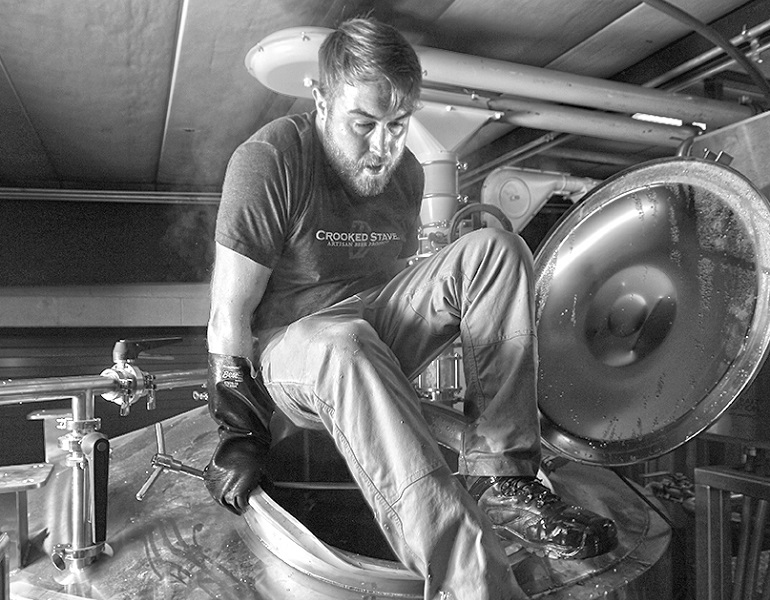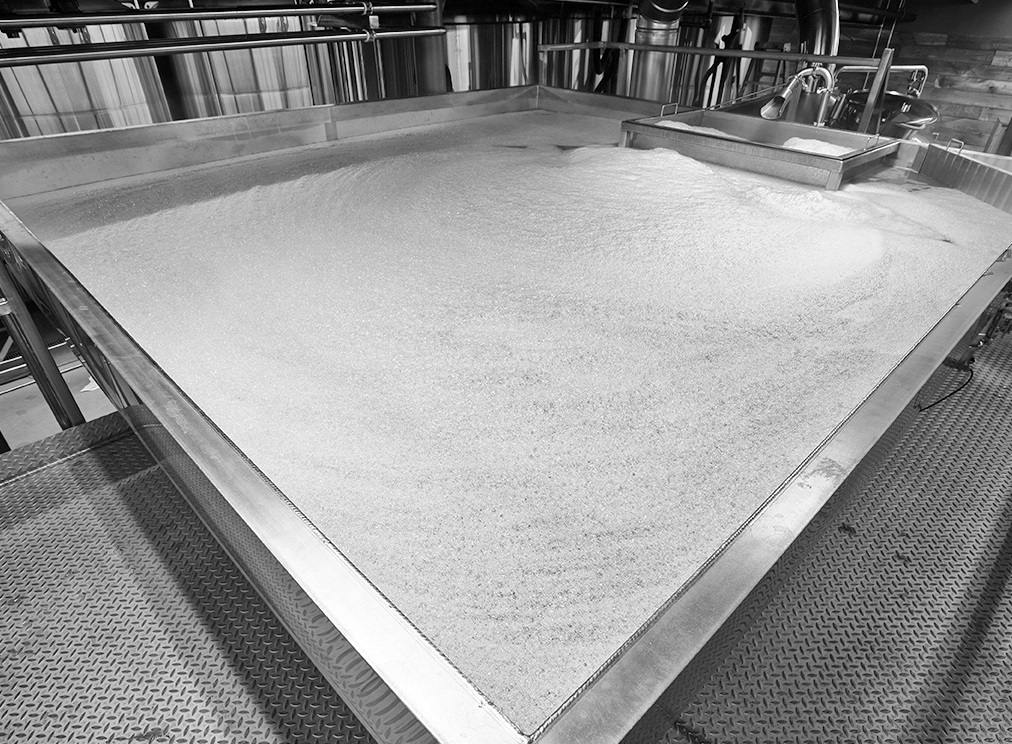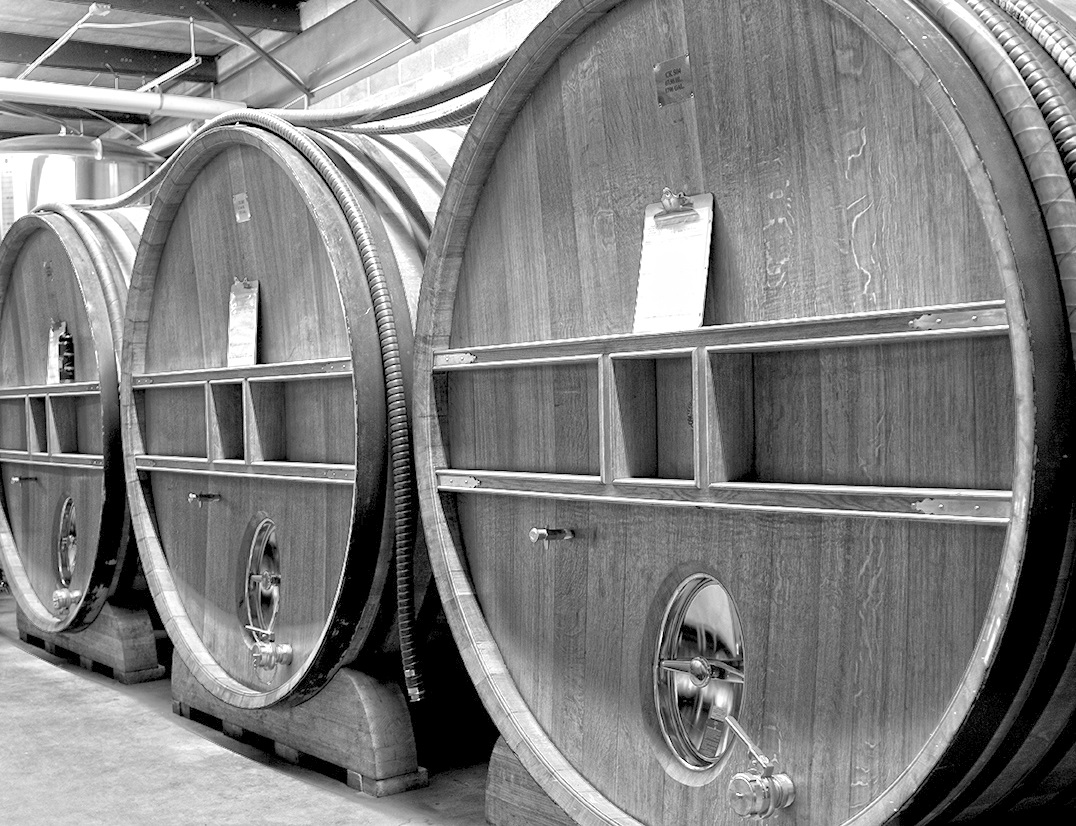Start 14-Day Trial Subscription
*No credit card required

Chad Yakobson of Crooked Stave
The image of the brewer who is part mad scientist and part artist has long been one of the iconic images of craft brewing lore. With Chad Yakobson, it seems to work the other way around. He's more of a pure scientist who gets a little crazy on the artistic side with his Crooked Stave Artisan Beer Project, where the specialty is mixed-culture fermentations and Brettanomyces beers.
While earning his master’s degree at Scotland's Heriot-Watt University in the school's distinguished center of brewing and distilling, Yakobson wrote his dissertation on Brettanomyces yeast, which is now beer-world famous. The idea was to isolate strains of Brettanomyces, then study how they worked in the fermentation of wort and what compounds they produced in the process. Available online, the dissertation reads scientifically, but is totally engaging for anyone interested in the process of making beer. It also serves as a great introduction to the underlying appeal of sour beer as a more creative vessel for brewers.
By understanding the characteristics and compounds produced in fermentation and by developing his own strains of yeast, Yakobson is like a painter who seeks to add more colors to his palette, then works on how to combine these colors to create unique renditions. When it comes to his processes to make the Crooked Stave beers, think Dali, maybe, then Matisse and some Jackson Pollock. The resulting beers such as the peach sour Persica, which is a fairly complex and approachable creation, can be pricey due to the amount of work, aging and expertise put into them at the brewery in the Sunnyside neighborhood of Denver. But beer aficionados continue to pony up and the brewery continues to grow, expanding from 2,000 barrels of production last year to 5,000 barrels this year.
New approaches to mixed-culture fermentation beers are part of a Nouvelle Vague in brewing, which would be somewhat difficult to pursue on a macro scale, but looks to play a significant role in the future of craft beer. Yakobson, who travels frequently to talk about his Brettanomyces Project, finds that America has become a jumping-off point for a worldwide surge in sour interest.
You travel and give talks regularly on the subject of brewing with a variety of yeast cultures and methods, especially concerning Brettanomyces. What is that experience like?
It’s really exciting. I was just in Amsterdam for Carnival Brettanomyces… One of the most interesting panels at the festival featured Jean van Roy, brewmaster at Cantillon, Yvan De Baets of Brasserie de la Senne and myself, brewers who do spontaneous beers. I'm very fortunate to call Jean a friend. Cantillon is a traditional brewery – it's over 100 years old, making spontaneous beers and using yeast that can’t be bought.
The trend that I'm seeing is sour beers are what people are really most interested in. It's what people know the least about.
As for barrel brewing, the science aspects are going from zero to 100. Five years ago most of what people knew about Brettanomyces or wild and sour beers wasn't correct – things that had been passed on for 20 or 30 years that came from wine or different research, and that weren’t the full truth.
The Crooked Stave beers are some of the most subtle and flavorful sours found in America or anywhere else. Is the brewing process as complicated as the beers taste?
I don't think beers need to be complicated – the less you touch it, the more the beer is going to show off its characteristics. It's not like you're in the kitchen and you're trying to make curry.

"I don't think beers need to be complicated – the less you touch it, the more the beer is going to show off its characteristics."
Crooked Stave has generally been on the high end of pricing in large part due to the number of steps and amount of fruit used, plus the expertise applied.
We continue to take it further and further every year at Crooked Stave. It continues to cost more and more every year. The quality and the time we put into these things is insane. I see where beers sell at $800 a bottle or $1,000 on the black market. I think it's pretty amazing that someone out there thinks our beer is worth $500 a bottle.
It's hard on the one hand as a beer drinker to see beer priced that high. You're starting to see more beers that are $50 and $80. At Crooked Stave, we are planning to release magnum bottles of beers, one and a half liters, and some might be upwards of $80. I think you're going to see more of that same format and price tier. Not from everyone, but from more and more breweries that have the ability to brew those kinds of beer.
A big storm occurred last spring on the first Persica Day, but turnout was good. Do you plan to have another one?
Persica is the first beer that really put us on the beer map about four years ago – it was a Colorado peach sour that we did. That was one that really got people's attention and got us going. We were a really, really small brewery.
We are working now on plans for a new taproom by the brewery. A big part of that taproom is so we can have releases like Persica Day and other festivals and celebrations.
The peaches are grown in Colorado?
Those are Palisades Peaches. The things we ask the farmers to do sound crazy. We ask them to leave it on the tree as long as possible – I want them to pick this peach at the point when you would pick it from the tree and enjoy it immediately. I want this fruit so ripe that it will go bad in a couple of days. We'll use 95,000 pounds of whole fruit this year, and sixty percent of that will be from Colorado.
You're an expert in identifying and generating pure yeast strains. For the everyday craft beer drinker, how would you sum up the value of generating your own pure yeast strains?
I would say the value comes with the choice and selection of flavors. If I enjoy them, we want to introduce them to other people. It gives us unique flavors and characteristics you're not going to find elsewhere. If you taste Crooked Stave, you're going to taste beers that are completely different. And that's important. The yeasts are our signature.

"If you taste Crooked Stave, you're going to taste beers that are completely different."
What do you find most attractive about mixed-culture fermentation? Is that also a signature of the brewery?
Absolutely. I'm an extremely process-oriented person. That probably is instilled in me from the master’s program I did at Heriot-Watt. A lot of that revolved around chemical engineering. It dictates to you that process is everything when you're brewing beer.
Mixed-culture fermentation is process, art and science. Over time as we blended our favorite beers into the foeders, those flora and cultures got ingrained in the wood. After a little while as we kept our fermentations in it, we started to realize the flavor changed to be more like the sour beers we have in smaller barrels.
For mixed-culture fermentation, we never buy anything from a lab, and we never have to inoculate any of our beers because this mixed culture exists throughout our entire brewery. It's in everything that's been allowed to be in the wood.
It's not a manipulation of flavors, and I mean that in a positive aspect. When we want to make a Kölsch, we buy a Kölsch yeast so that we get the yeast strain that makes the beer we set out to make. But our house beers come from the yeast in our foeders that's come together naturally. Fortunately, they're the flavors we really love and we're very proud of them.
You have an entire room full of foeders, but only three of them have the Brettanomyces cultures you've created in-house?
Two of the Brett strains are really the signature flavors of our beers. All the other vertical foeders got beer blended into them, and sometimes they were used for primary fermentation. When we get new foeders, beer goes straight into them and they start to build up their mixed culture. Some of it is from the beer that was in wine barrels. In those wine barrels we've got naturally occurring bacteria and wild yeast. We've had everything developing throughout our brewery in very symbiotic ways.

Everything at Crooked Stave develops symbiotically, including the mixed-culture and naturally occurring yeast and bacteria found within the brewery's foeders.
How do you keep the Brett cultures isolated and keep them from invading the rest of the brewery?
We've segregated out everything and transfer everything into stainless steel pipes. We don't ferment any of the mixed-culture stuff in stainless, that's all primary fermented in oak.
We have three sets of color-coded hoses and pumps: Green means clean, Brett is black and red is for sour. Same thing for our valves and everything the beer will touch.
What's the background on the Sourless IPA?
I was in Kansas City for a festival called Boulevardia. There was a brewer who'd gotten a little drunk, and he challenged me to make a clean beer. Every beer we make before a sour is a clean beer. He was just having fun. I told him, ‘I'll take you up on that challenge.’
I brewed a lot of IPA when I worked for Odell in Ft. Collins. Now I like more English-style yeast characteristics for IPA, as long as you can get them to ferment out.
I’ve wanted to brew this IPA for six years. When I went out to visit and brew with Shaun Hill at Hill Farmstead in 2012, Heady Topper had been around for a little while and was starting to grow in popularity. I tasted one of Shaun’s IPAs and was blown away, and I thought to myself, 'Oh my God. I thought I was the only person who wanted to brew a beer like this!' Well, six years later, those types of unfiltered IPAs are becoming popular. Now that we finally have our own brewhouse and it’s dialed in, we are brewing everything we have always wanted to.
Our IPA is very centered on flavor and aroma. When you're drinking it you're tasting apricots and pineapple juice – very, very juicy characteristics. It obviously comes from hops and not from fruit, but very heavy on the aroma and flavor is what we're going for.

Photos by The Brewtography Project/Courtesy Crooked Stave



